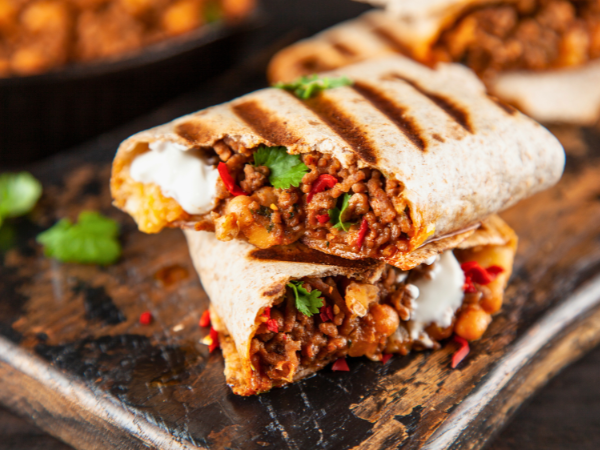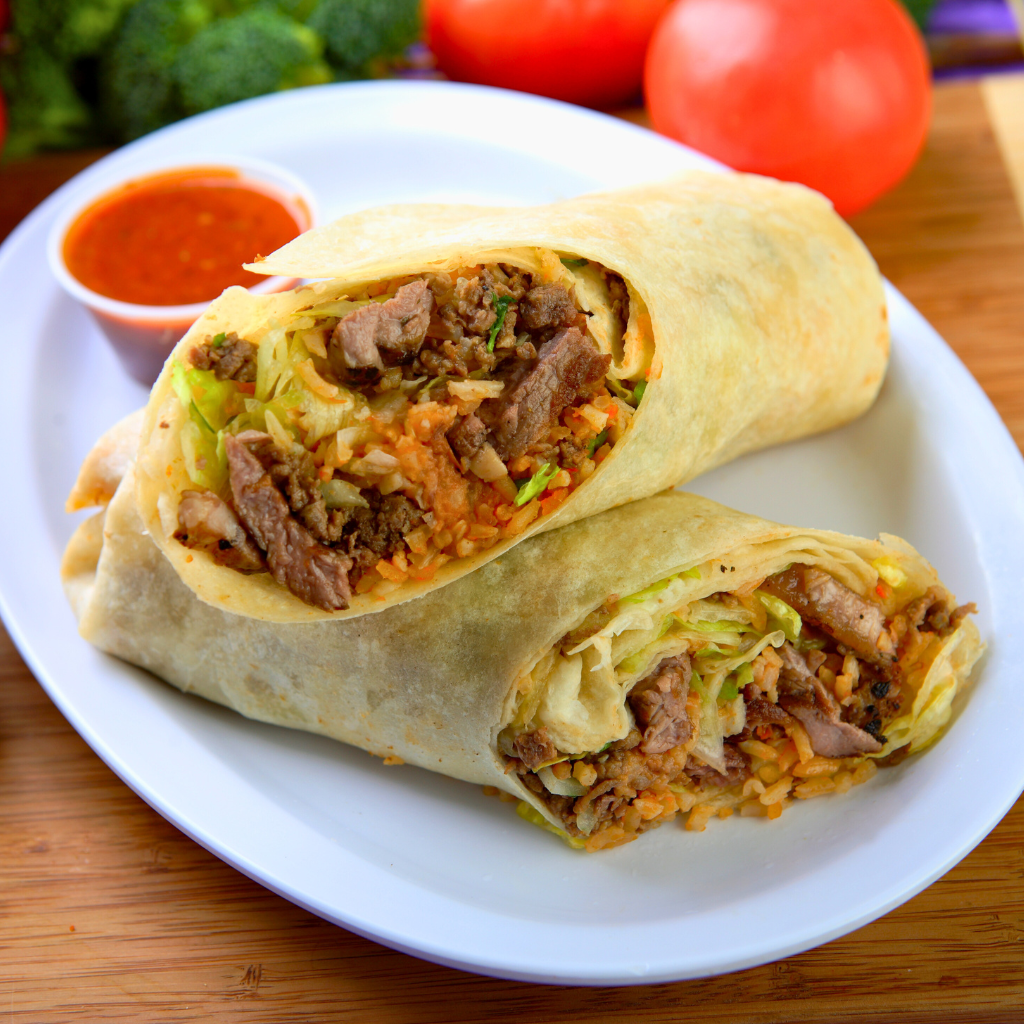A burrito typically includes grains, proteins, vegetables, dairy, and sometimes fruits. These food groups provide a balanced meal.
A burrito is a versatile and popular dish enjoyed by many. It is known for its diverse and nutritious ingredients. The combination of various food groups ensures a well-rounded meal that caters to different dietary needs. Grains usually come from the tortilla, while proteins may include beans, meat, or tofu.
Table of Contents
Burrito Basics
The burrito is a popular Mexican dish that many people love. But what food groups are in a burrito? This comprehensive breakdown will help you understand the basics. Let’s dive into the Burrito Basics to uncover what makes this dish so delicious and nutritious.
History Of Burritos
The burrito has a fascinating history that dates back centuries. It is believed to have originated in Mexico and has evolved over time. The word “burrito” means “little donkey” in Spanish. There are several theories about how the burrito got its name:
- One theory suggests that the name comes from the way burritos are packed, similar to how donkeys carry loads.
- Another theory is that a man named Juan Méndez used donkeys to transport his food, which were wrapped in flour tortillas.
Burritos gained popularity in the United States during the 20th century. Mexican immigrants introduced them to American cuisine. Today, burritos are enjoyed worldwide and come in various styles and flavors.
Common Ingredients
Burritos are versatile and can include various ingredients. These ingredients fall into different food groups, making burritos a balanced meal. Here are some common ingredients found in burritos:
- Protein: Beef, chicken, pork, beans, tofu
- Grains: Flour tortillas, rice
- Dairy: Cheese, sour cream
- Vegetables: Lettuce, tomatoes, onions, peppers
- Fruits: Avocado, salsa
Each ingredient adds flavor and nutritional value to the burrito. For example, proteins help build muscles, while grains provide energy. Dairy products add calcium for strong bones. Vegetables and fruits are rich in vitamins and minerals.
Here’s a quick look at the food groups and their benefits:
| Food Group | Examples | Benefits |
|---|---|---|
| Protein | Beef, chicken, beans | Builds muscles |
| Grains | Tortillas, rice | Provides energy |
| Dairy | Cheese, sour cream | Strengthens bones |
| Vegetables | Lettuce, tomatoes | Rich in vitamins |
| Fruits | Avocado, salsa | Rich in minerals |
Next time you enjoy a burrito, you’ll know exactly what makes it nutritious and tasty!
Grain Group
One important part of a burrito is the grain group. This group provides the energy and carbs you need. Let’s explore the grain group in burritos.
Types Of Tortillas
Tortillas are the foundation of any burrito. There are different types, each with unique flavors and textures. The most common types include:
- Flour Tortillas: Made from wheat flour, they are soft and flexible. Perfect for wrapping and folding burritos.
- Corn Tortillas: Made from maize, they have a rich, earthy flavor. They are gluten-free and have a firmer texture.
- Whole Wheat Tortillas: These are similar to flour tortillas but made from whole wheat. They offer more fiber and nutrients.
- Spinach Tortillas: Infused with spinach, these tortillas add a boost of vitamins and a green color.
Each type of tortilla adds a unique taste and texture to your burrito. Choose the one that fits your dietary needs and taste preferences.
Nutritional Benefits
The grain group in burritos, mainly from tortillas, offers numerous nutritional benefits:
- Carbohydrates: Tortillas provide a good source of carbs. These are essential for energy.
- Fiber: Whole wheat and corn tortillas offer more fiber. Fiber aids in digestion and keeps you full longer.
- Vitamins and Minerals: Spinach tortillas add extra vitamins A and K. Whole wheat tortillas offer more iron and magnesium.
- Gluten-Free Options: Corn tortillas are gluten-free, making them a good choice for people with gluten intolerance.
Choosing the right tortilla can enhance the nutritional value of your burrito. Pay attention to your dietary needs and pick the best option for you.

Protein Sources
One of the key components of a burrito is the protein source, which can vary widely based on dietary preferences.
Meat Options
Meat is a popular choice for burrito fillings, providing a rich source of protein and flavor. Here are some common meat options:
- Chicken: Grilled or shredded chicken is a lean protein option. It’s often seasoned with spices like cumin and chili powder.
- Beef: Ground beef or steak strips are classic choices. They can be cooked with onions, garlic, and various spices to enhance their taste.
- Pork: Carnitas, or slow-cooked pulled pork, adds a tender and juicy element. Pork is often cooked with citrus and spices for a tangy flavor.
- Fish: Grilled or fried fish can be a lighter alternative. Common choices include tilapia or cod, often seasoned with lime and cilantro.
Here’s a quick comparison of the nutritional values of these meat options:
| Meat Type | Calories (per 100g) | Protein (g) | Fat (g) |
|---|---|---|---|
| Chicken | 165 | 31 | 3.6 |
| Beef | 250 | 26 | 15 |
| Pork | 242 | 27 | 14 |
| Fish | 206 | 22 | 12 |
Vegetarian Alternatives
For those who prefer plant-based options, there are plenty of vegetarian protein sources for burritos. These alternatives can be just as satisfying and nutritious:
- Beans: Black beans and pinto beans are common choices. They are rich in protein and fiber, making them a filling option.
- Tofu: Tofu can be grilled or sautéed with spices. It absorbs flavors well and provides a good amount of protein.
- Tempeh: This fermented soybean product has a nutty flavor and firm texture. It’s packed with protein and probiotics.
- Seitan: Made from wheat gluten, seitan is a high-protein meat substitute. It has a chewy texture and can be seasoned to taste.
Here’s a quick comparison of the nutritional values of these vegetarian options:
| Vegetarian Option | Calories (per 100g) | Protein (g) | Fiber (g) |
|---|---|---|---|
| Black Beans | 132 | 8.9 | 8.7 |
| Tofu | 76 | 8 | 0.3 |
| Tempeh | 192 | 19 | 5.4 |
| Seitan | 370 | 75 | 0 |
Whether you prefer meat or vegetarian options, the protein source in your burrito can be tailored to your taste and nutritional needs.
Vegetable Variety
Vegetables add color, crunch, and nutrients to your burrito, making it not just tasty but also healthy. Let’s dive into the types of veggies you can enjoy in your burrito.
Fresh Veggies
Fresh vegetables provide a crisp texture and vibrant flavor to any burrito. They are usually added raw to preserve their nutrients and crunchiness. Some popular fresh veggies include:
- Lettuce: Adds a refreshing crunch and is low in calories.
- Tomatoes: Juicy and sweet, they provide a burst of flavor.
- Onions: Offer a sharp, tangy taste that complements other ingredients.
- Bell Peppers: Colorful and slightly sweet, they add a great crunch.
- Cilantro: Adds a fresh, citrusy note that enhances the overall flavor.
These fresh veggies not only enhance the flavor but also add essential vitamins and minerals to your burrito. For example, tomatoes are high in vitamin C, while bell peppers provide vitamin A. Combining these fresh ingredients ensures you get a delicious and nutritious meal.
Cooked Additions
Cooked vegetables bring a different texture and depth of flavor to your burrito. They are often sautéed, grilled, or roasted to bring out their natural sweetness and richness. Some common cooked veggie options include:
- Onions: When caramelized, they add a sweet and savory flavor.
- Bell Peppers: Grilled or roasted, they become tender and smoky.
- Zucchini: Sautéed, they add a mild, slightly sweet taste.
- Mushrooms: Provide a meaty texture and umami flavor when cooked.
- Corn: Grilled corn adds a sweet, slightly charred flavor.
Dairy Delights
One of the most beloved food groups in a burrito is dairy. Dairy products add a creamy texture and rich flavor that many people crave. This section will explore the delightful dairy options commonly found in burritos.
Cheese Choices
Cheese is a staple in many burritos. It melts beautifully and adds a rich, savory taste. There are several types of cheese you can include:
- Cheddar Cheese: Sharp and tangy, it melts well and adds a robust flavor.
- Monterey Jack: Mild and creamy, perfect for those who prefer a less intense cheese.
- Queso Fresco: A crumbly, fresh cheese that adds a light, milky taste.
- Mexican Blend: A mix of cheeses like Cheddar, Monterey Jack, and Queso Blanco for a balanced flavor.
The table below summarizes the characteristics of these cheeses:
| Cheese Type | Flavor Profile | Texture |
|---|---|---|
| Cheddar | Sharp and Tangy | Firm |
| Monterey Jack | Mild and Creamy | Semi-Soft |
| Queso Fresco | Light and Milky | Crumbly |
| Mexican Blend | Balanced | Varied |
Sour Cream And Yogurt
Sour cream and yogurt are popular dairy additions to burritos. They both provide a creamy texture and a tangy taste:
- Sour Cream: A classic choice, it adds a rich, tangy flavor that complements spicy and savory ingredients.
- Greek Yogurt: Thick and tangy, it’s a healthier alternative to sour cream with added protein.
- Plain Yogurt: A milder, more versatile option that can be used to tone down spiciness.
These options can be added on top or mixed into the filling. They enhance the overall flavor and texture of the burrito. Here are some benefits of each:
| Dairy Product | Benefits |
|---|---|
| Sour Cream | Rich Flavor, Creamy Texture |
| Greek Yogurt | High Protein, Thick Texture |
| Plain Yogurt | Mild Flavor, Versatile |
Using these dairy products can elevate your burrito from good to great. Whether you prefer the classic richness of sour cream or the health benefits of yogurt, there’s a dairy option for everyone.
Flavor Enhancers
Flavor enhancers play a crucial role in elevating the taste and adding depth to each bite. These enhancers include salsas, sauces, spices, and herbs.
Salsas And Sauces
Salsas and sauces are essential to a burrito’s flavor profile. They bring a burst of taste that complements the other ingredients. Here are some popular options:
- Pico de Gallo: A fresh, chunky salsa with tomatoes, onions, cilantro, and lime juice.
- Guacamole: Creamy avocado mixed with lime, cilantro, tomatoes, and onions.
- Sour Cream: Adds a tangy, creamy element to balance spicy flavors.
- Red Salsa: Made with tomatoes, chilies, and spices, offering a rich, spicy kick.
- Green Salsa (Salsa Verde): A tangy sauce made from tomatillos, green chilies, and cilantro.
Table of Common Salsas and Sauces:
| Salsa/Sauce | Primary Ingredients | Flavor Profile |
|---|---|---|
| Pico de Gallo | Tomatoes, Onions, Cilantro, Lime Juice | Fresh, Tangy |
| Guacamole | Avocado, Lime, Cilantro, Tomatoes, Onions | Creamy, Rich |
| Sour Cream | Cultured Cream | Tangy, Creamy |
| Red Salsa | Tomatoes, Chilies, Spices | Spicy, Rich |
| Salsa Verde | Tomatillos, Green Chilies, Cilantro | Tangy, Zesty |
Spices And Herbs
Spices and herbs infuse the burrito with aromatic flavors and enhance the overall taste experience. Here are some key spices and herbs used in burritos:
- Cumin: Adds a warm, earthy flavor, often found in taco seasoning.
- Chili Powder: Brings heat and depth, commonly used in meat fillings.
- Oregano: Offers a slightly bitter, peppery taste, great in sauces and meat.
- Garlic: Provides a pungent, savory note, essential in many salsas and marinades.
- Cilantro: Adds a fresh, citrusy touch, often used in salsas and as a garnish.
Table of Common Spices and Herbs:
| Spice/Herb | Flavor Profile | Common Uses |
|---|---|---|
| Cumin | Warm, Earthy | Meat Fillings, Spice Mixes |
| Chili Powder | Spicy, Deep | Meat Fillings, Sauces |
| Oregano | Bitter, Peppery | Sauces, Meat Fillings |
| Garlic | Pungent, Savory | Salsas, Marinades |
| Cilantro | Fresh, Citrusy | Salsas, Garnish |
Nutrition Burrito
The ‘Nutrition Burrito’ explores the caloric content and nutritional breakdown of this popular dish.
Caloric Content
The calories in a burrito depend on its ingredients. A basic burrito with rice, beans, cheese, and a tortilla has around 500-700 calories. Adding meats like chicken or beef increases the calorie count. Here’s a quick look:
- Rice: 200 calories per cup
- Beans: 150 calories per cup
- Cheese: 100 calories per ounce
- Tortilla: 150-200 calories
- Chicken: 150 calories per 3 oz
- Beef: 250 calories per 3 oz
Adding other ingredients like sour cream or guacamole increases the calories. It’s essential to balance your burrito with healthy choices.
Nutritional Breakdown
A burrito offers a mix of nutrients. Let’s break it down:
| Ingredient | Carbs | Proteins | Fats |
|---|---|---|---|
| Rice | 45g | 4g | 0.5g |
| Beans | 30g | 15g | 1g |
| Cheese | 1g | 7g | 9g |
| Tortilla | 25g | 4g | 5g |
| Chicken | 0g | 26g | 3g |
| Beef | 0g | 26g | 15g |
A burrito provides a good source of carbohydrates from rice and tortillas. Proteins come from beans and meats. Fats are mainly from cheese and meats. Keep these factors in mind for a balanced diet.
Frequently Asked Questions
What Does A Burrito Consist Of?
A burrito consists of a flour tortilla filled with ingredients like rice, beans, meat, cheese, and vegetables. It often includes salsa, guacamole, and sour cream.
What Are The Macronutrients In A Burrito?
A burrito contains three main macronutrients: proteins, carbohydrates, and fats. Beans and meat provide protein, while tortillas offer carbohydrates. Cheese and sour cream add fats.
What Food Groups Are Represented In A Taco?
A taco includes protein from meat or beans, vegetables like lettuce and tomatoes, dairy from cheese, and grains from the tortilla.
Is A Burrito A Balanced Meal?
A burrito can be a balanced meal if it includes protein, vegetables, healthy fats, and whole grains. Choose lean meats, beans, and plenty of veggies for optimal nutrition.



